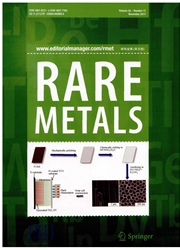

 中文摘要:
中文摘要:
通过结构和磁性测量,研究了Ni50-xMn39Sn11(x=0,2,4,6)Heusler合金的晶体结构、相变和磁性.结果表明,随Co含量增加,该系列合金的马氏体相变温度明显下降,而Curie温度却呈现出上升的趋势,并在室温下展现出不同的晶体结构.同时,Co含量的增加导致样品在奥氏体相的磁性迅速增加,而马氏体相的磁性却几乎保持不变,显著地提高了2相之间的磁化强度差异(△M).特别是当Co含量增加到x=4时,2相之间的ΔM达到40AmVkg,并表现出磁场驱动马氏体相变的特征.此外,还研究了Ni50-xCoxMn39Sn11(x=0,2,4)样品在马氏体相变过程中的应变行为.其中,x=4样品的相变应变量达到了0.17%,通过3T的磁场循环,该样品在215~235K的温度范围均显示出可回复磁感生应变.这种可回复的应变行为可归因于样品中的部分马氏体相变可由等温磁场驱动.
 英文摘要:
英文摘要:
The crystal structure, phase transformations and magnetic properties for Ni50-xCoxMn39Sn11 (x=0, 2, 4, 6) Heusler alloys have been systematically studied by means of structure and magnetism measurements. The re- sults show that with increase of Co concentration, the martensitic transformation temperatures are obviously de- creased, while the Curie temperatures of austenite are gradually increased, and they present different structures at room temperature. At the same time, with increasing Co content, the austenitic magnetism rapidly enhances, while the martensitic magnetism almost keeps unchanged. This leads to a significant improvement of difference magneti-zation (△AM) between two phases. For Co content added to x=4, the value of AM between two phases achieves about 40 Am^2/kg and exhibits magnetic field-induced martensitic transformation. Using strain measurement, the strain behavior related to martensitic transition in Ni50-xCoxMn39Sn11 (x=0, 2, 4) samples was studied. It is found that the phase transition strain reaches 0.17% in Ni46Co4Mn39 Sn11 sample. Within the magnetic cycles of 3 T, this sample displays a reproducible magnetostrain in temperature range of 215-235 K. Such a reproducible strain could be ascribed to the fact that a partial martensitic transformation of this sample can be driven by isothermal magnetic field.
 同期刊论文项目
同期刊论文项目
 同项目期刊论文
同项目期刊论文
 期刊信息
期刊信息
